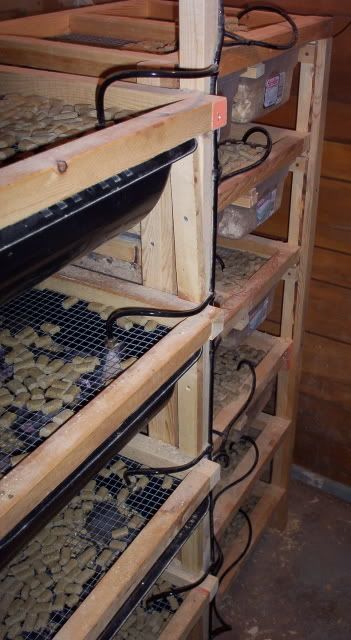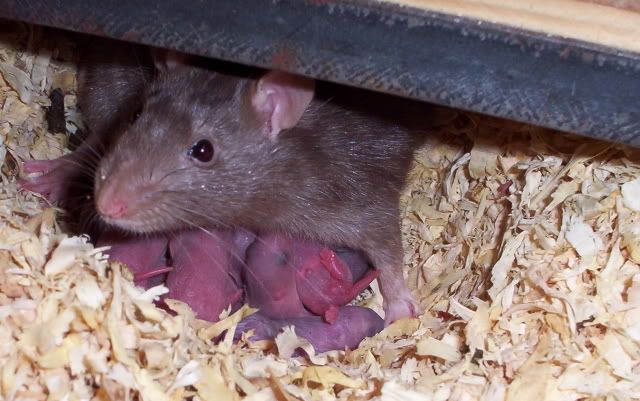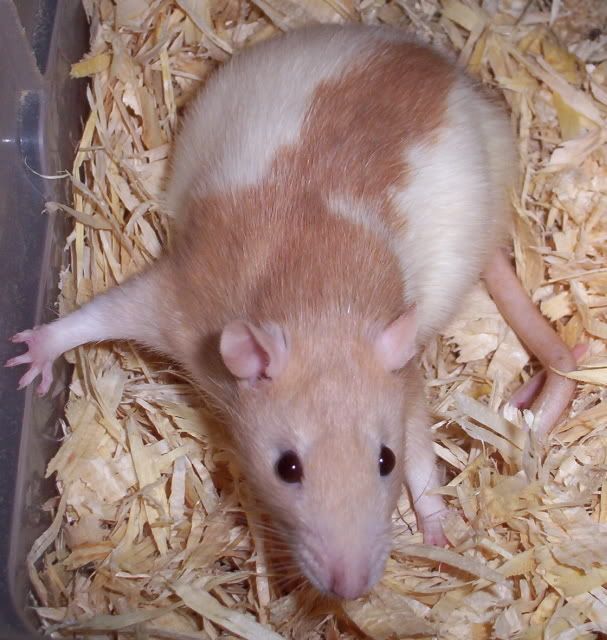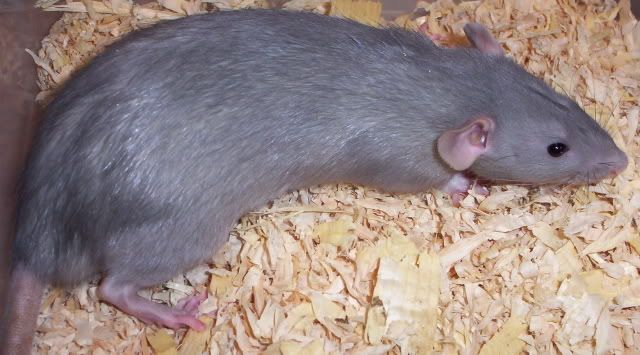BREEDING RATS
Why Breed Rats?
Rats are a great whole food item for captive predators, especially reptiles and raptors. Rats are a common food item for these animals in the wild and breeding rats for their consumption in captivity is an easy way to provide a healthy and natural diet. Because the domestic rat breeds so readily, has large litters of fast growing young and is easy to care for, it is a great choice for the keeper who wishes to produce a good food supply for his animals. Aside from simply being easy to produce, rats are a lot of fun to have around. Each one has its own personality and they can be quite comical at times. You will soon find that certain individuals will become your favorites in a breeding group and the more you interact with them the more entertainment they provide! Perhaps the biggest reason for breeding rats at home is the financial aspect of it. Buying rats frozen is the normal alternative, but you can save a lot of money by breeding them yourself, which I will get into later on.
Rats are rather undemanding captives. If given food, water and shelter rats will breed willingly. Aside from these basics, I believe temperature plays the biggest roll in rat production. Rats put out a massive amount of heat for their size and thus they need a cool environment. I prefer to keep them at no more than 60 degrees f.
Housing: Rats are social animals and can be housed in large numbers. Of course there are limits to how many rats can be housed in a given area, but as long as common sense is used you can fit a lot of rats in a small room. The most common method of housing is racks. Rat Racks consist of a framework that holds rows of tubs that can slide in and out. Each tub sits under a framed top that has a hardware cloth bottom. This hardware cloth serves 3 purposes. It keeps the rats in the tubs, holds the food, and acts as an anchor for the water nozzles. I prefer to use 1/2 inch hardware cloth.

Racks can be made out of many things but wood tends to be the preferred material. The dimensions of the rack will depend on the types of tubs you choose to house your rats in. Often a variety of sizes are used to accommodate different individual animals or groups of animals. I keep my males in large concrete mixing tubs, and single females are kept in 12 qut. Sterilite containers. But I have other racks that hold 32 qut and 41 qut tubs for growing weaned rats. Its all a matter of preference. Cat litter tubs are commonly used as well. The most important factors to consider when buying tubs, is to find tubs with a height of 6-7 inches that have a smooth inner surface. Any edges or sharp corners will be a target for chewing by the rats, and they can chew through a tub very quickly.
Bedding: Aspen shavings are a good bedding for rats. They are non-abrasive and very absorbent. Aspens biggest drawback is its price. Aspen can be pricey, even when bought in bulk. That’s why I use and recommend pine bedding for rats. There are debates that would lead a person to believe that pine and cedar bedding is naturally toxic and irritating to rats. And I believe that cedar is and should be avoided completely but, my experience has been that pine works quite well and the rats show no ill effects from being in contact with it.
Food: Rats will eat just about anything. My experience and the experience of others has lead me to believe that the best diet you can feed a breeding colony of rats is Mazuri 6f rodent breeder formula. My rats are maintained on this pellet formula exclusively, but I'm sure that adding the occasional seeds or greens to their diet might help. If feeding such a pelleted diet, you can simply pile the food on the wire on top of the cages, the rats can easily eat through the wire yet are unable to soil the food with urine or feces.
Water: Rats drink a lot and need a constant supply of fresh water. There are two simple ways to give them the water they need, one of which is easier than the other. The first and easiest option is to use an automatic watering system which basically consist of a refillable reservoir that feeds a series of tubes that end with a nozzle in each housing compartment. This system can be supplied directly from a water line but you must install some sort of pressure regulator if you do this. I prefer the 3/16" tubing and accessories.

The second watering option is to use the traditional rodent watering bottles, but care must be taken not to let them run dry, and they also have a habit of sticking open more often than the automatic nozzles, and this can be quite messy.
The Basics of Rat Reproduction
Female rats cycle every 4-5 days, so by placing a group of females with a male for one week they should all be bred during that time. A male can easily breed 5 or 6 females and if space permits possibly many more. After spending 7 days with a male, the females should be moved into individual tubs where they can build a nest and after a 21 day gestation, give birth to a litter of pups. I've found that 10-12 pups is average and up to 18 or more is not uncommon. After 28 days with the mother the young can be weaned and placed in groups of 10 - 15 in larger tubs. From here they can be grown to the desired size and the females can be placed back with the male.
An additional 4 weeks of growth for weaned rats should yield sexually mature rats they weigh around 200 grams. With males being slightly larger than females on average. When it's all said and done the process from conception to weaning takes approx. 54 days. With an average litter size of 10 pups, a single female should produce 60 offspring in a given year. And a group of 10 females should yield at least 600 offspring (potentially much more).
Cost Comparisons
It is unfortunate that I have not calculated exactly how much each rat I produce actually costs to make. But I know it's substantially less than buying frozen rats. In order to secure a single shipment of 600 rats weighing an average of 200 grams it would costs nearly $1400. That price of course includes shipping. That's approx. $2.28 per rat. If I were to guess I would say that it costs me less than $300 to produce 600 rats.

Now lets assume that a person has one animal and they wish to feed this animal one rat per day. That's 365 rats in a year. What would be the best way to produce your rats? Well it all depends on how big you want them, and how you wish to feed them, frozen/thawed or freshly killed. If you want to freeze your rats simply come up with a number of females that should (on average) meet your needs. In this case 5 or 6 females should be more than enough. By breeding them all at once you should have an average of 60 fully mature rats to kill and freeze every couple of months. But if fresh meat is your preference, you will have to be much more precise about when each female gets to reproduce.....But that's a whole nother can o' worms!
To buy a years worth of frozen rats would costs almost $850. If you divided the total into 4 quarterly shipments of rats it would cost over $900 dollars for the year! Trust me...its easier to make them yourself.
Other Things to Consider
Breeding rats can be as simple or as involved as you want it to be. Along the way there are things that you can do that can add not only financial gain, but make things a little more fun as well. One of these things is breeding rarities of the rat world. There are numerous "fancy" colors of rats that are desired in the pet market, as well as other genetic traits that change the over all appearance of rats, such as dumbo (big ears) , rex (fur type), hairless and even tailless rats . By adding a few of these to your existing colony you can sell the best of there offspring to local pet stores, and in most cases you can make enough money from this to supply food for your whole colony! I enjoy having other rodents such as hampsters and mice around from time to time and the same can be done with these to help curve other costs.
 Other things you can do to increase the efficiency of your colony are replacing your old breeders as soon as they stop producing or when they become sporadic about making a litter. Very seldomly does a good female not produce a litter when left with a male for a week. Culling is another good thing to practice as well as selective breeding. Any female that produces less than your desired litter size more than a couple times in a row (excluding her first litter) should be culled from the colony. As you produce more and more rats you will notice indivuduals that stand out and have a robust healthy look, more so than there litter mates. These individuals are good stock to hold onto and place back into the breeding program. Males love breeding, but males that are in constant company with females become lax and wont be as productive as they could be. So keep your males alone untill you have a group of females ready for breeding. Males should be replaced often, a strong 10 week old male is a breeding machine and will quickly out do his older rivals. Also I like to cull out the biters. Rats have a powerfull bite and some are more prone to be protective than others. If a female bites me when Im checking her litter or just cleaning the cage, its pretty much a death sentence for her! Staying in tune with your colony and keeping a watchfull eye on things will insure a better, more productive breeding program.
Other things you can do to increase the efficiency of your colony are replacing your old breeders as soon as they stop producing or when they become sporadic about making a litter. Very seldomly does a good female not produce a litter when left with a male for a week. Culling is another good thing to practice as well as selective breeding. Any female that produces less than your desired litter size more than a couple times in a row (excluding her first litter) should be culled from the colony. As you produce more and more rats you will notice indivuduals that stand out and have a robust healthy look, more so than there litter mates. These individuals are good stock to hold onto and place back into the breeding program. Males love breeding, but males that are in constant company with females become lax and wont be as productive as they could be. So keep your males alone untill you have a group of females ready for breeding. Males should be replaced often, a strong 10 week old male is a breeding machine and will quickly out do his older rivals. Also I like to cull out the biters. Rats have a powerfull bite and some are more prone to be protective than others. If a female bites me when Im checking her litter or just cleaning the cage, its pretty much a death sentence for her! Staying in tune with your colony and keeping a watchfull eye on things will insure a better, more productive breeding program.
 Other things you can do to increase the efficiency of your colony are replacing your old breeders as soon as they stop producing or when they become sporadic about making a litter. Very seldomly does a good female not produce a litter when left with a male for a week. Culling is another good thing to practice as well as selective breeding. Any female that produces less than your desired litter size more than a couple times in a row (excluding her first litter) should be culled from the colony. As you produce more and more rats you will notice indivuduals that stand out and have a robust healthy look, more so than there litter mates. These individuals are good stock to hold onto and place back into the breeding program. Males love breeding, but males that are in constant company with females become lax and wont be as productive as they could be. So keep your males alone untill you have a group of females ready for breeding. Males should be replaced often, a strong 10 week old male is a breeding machine and will quickly out do his older rivals. Also I like to cull out the biters. Rats have a powerfull bite and some are more prone to be protective than others. If a female bites me when Im checking her litter or just cleaning the cage, its pretty much a death sentence for her! Staying in tune with your colony and keeping a watchfull eye on things will insure a better, more productive breeding program.
Other things you can do to increase the efficiency of your colony are replacing your old breeders as soon as they stop producing or when they become sporadic about making a litter. Very seldomly does a good female not produce a litter when left with a male for a week. Culling is another good thing to practice as well as selective breeding. Any female that produces less than your desired litter size more than a couple times in a row (excluding her first litter) should be culled from the colony. As you produce more and more rats you will notice indivuduals that stand out and have a robust healthy look, more so than there litter mates. These individuals are good stock to hold onto and place back into the breeding program. Males love breeding, but males that are in constant company with females become lax and wont be as productive as they could be. So keep your males alone untill you have a group of females ready for breeding. Males should be replaced often, a strong 10 week old male is a breeding machine and will quickly out do his older rivals. Also I like to cull out the biters. Rats have a powerfull bite and some are more prone to be protective than others. If a female bites me when Im checking her litter or just cleaning the cage, its pretty much a death sentence for her! Staying in tune with your colony and keeping a watchfull eye on things will insure a better, more productive breeding program.